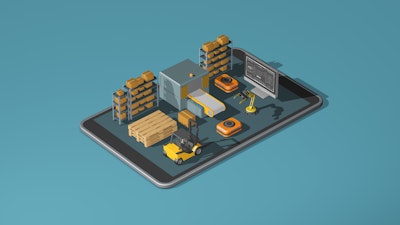
Juggling all the components necessary to successfully operate a Distribution Center has always been challenging, becoming even more complicated recently. Usually, increases in sales volume are welcomed, but market factors since 2020 have complicated matters. The surge in order demand, especially e-commerce and B2B, created a need to fulfill orders in a shorter delivery time window while relying on a workforce of new or temporary workers.
Another major management issue is attracting, training and retaining the new workforce necessary to perform the pick, pack and ship order fulfillment activities. Competition for workers has caused a constant workforce ebb and flow, with the cost of recruiting, hiring and training new workers reaching above $5,000 per hire. Last month, a report from Amazon revealed that only one-third of its new warehouse hires stay with the company longer than 90 days. The impact is so severe that the attrition rate is costing the company $8 billion a year– a quarter of the company’s profit for 2021.
How do you keep your people on the payroll while increasing their productivity to fulfill orders? The answer is maximizing a combination of elements:
- A stable, productive workforce that can perform work with minimal wasted walking.
- Warehouses deploying third-generation robots (AMRs) and Goods to Person solutions to enable more efficient picking, replenishment, and product storing.
- A blend of automation technologies orchestrated by a Tier 1 Warehouse Automation system to optimize and coordinate work activities between robots and workers.
- A voice-directed picking system that guides workers step by step using mobile wearable computers, headsets, and hands-free barcode scanning to guide them through complex work procedures.
People play a role
Now and well into the future, warehouses need to invest in the right blend of automation to operate with fewer people. People are not going away because of their cognitive and creative abilities to adapt to process changes or handle an exception quickly.
Robots are great for moving, picking and sorting under minimal human supervision. But even as performance increases and costs decrease, robots supplement– not replace –people, simply taking away mundane tasks.
AMRs reduce wasted labor
In non-automated operations, workers can spend 35% or more of their time walking in the warehouse, often visiting the same pick locations one hundred times per day in discrete-order picking operations. Since order picking can consume 50% or more of a DC’s labor spend, eliminating 50% or more of workers’ walk time is an instant boost in productivity, especially when an operation has 15 or more workers performing order picking.
For example, implementing an AMR batch pick cart system that replaces manual picking push carts can more than double the operator’s pick rate. AMR picking solutions can achieve 250 lines per picker in the warehouse using a combination of pick by voice combined with AMR’s performing the pick-up moves throughout the pick locations and cart drops at the packing automation line. These mobile robots are safe and nimble at navigating throughout the warehouse, automatically moving batch pick carts containing 15-25 orders at a time.
Hybrid robotic G2P systems that are highly scalable and adaptable to small and mid-size warehouses are rapidly emerging. These systems combine the use of two robots working together to boost picking and storage. The “bots” rapidly deliver up to 250 totes per hour to the pick-station operator.
Orchestrating AMRs, G2P and workers
A top-tier Warehouse Execution and Control System, WES-WCS software platform, is necessary to enable the entire warehouse pick, pack and ship automation system to high-level performance. Real-time software optimizes order release across the G2P and other warehouse picking zones to increase productivity and lower manual labor dependency.
The software fully synchronizes people, AMRs and G2P solutions for more efficient picking. Additionally, the integration of an automated pack and ship line can reduce 50 to 80% of the manual labor associated with packing, manifesting and shipping cartons and polybag packed orders, providing a much faster ROI than picking an automation-only solution!
The system manages the AMRs and pickers’ movements in a single application. Order release, batch cubing and real-time pick-by voice seamlessly matches the movement of pickers and AMRs from order start, pick-up and zone transport of large-capacity batch pick carts throughout the warehouse’s multiple pick zone.
Integrating workers with warehouse automation
The latest generation multi-modal voice technology is simple to use and guides the worker step by step through picking, replenishment, and pallet-building tasks. A new worker or temporary employee can be trained and productive in 15 to 20 minutes.
Equipping your workforce with a voice-enabled mobile wireless wearable computer, blue-tooth wireless, hands-free bar code scanner and headset integrates and directs workers more efficiently in manual pick zones and magnifies their performance when AMRs are their partners. Voice technology that combines voice commands with “hands-free” camera-based barcode scan validation and a wearable forearm mounted touch screen display that shows picked item number and quantity instructions and an image of the product to pick boosts productivity and accuracy far beyond RF-directed or traditional voice base picking technology.
Voice has grown to a complete warehouse software application suite module that reduces labor and increases accuracy across each component of warehouse pick, pack and ship operations. The results are faster, safer and easier work to create less stress on new and existing employees.
Benefits of coordinating all elements in the warehouse
Synchronizing and automating warehouse activities by uniting robots and workers with voice picking and wearables leads to significant operational improvements and a more competitive and profitable business:
- Gains of 80 to 200 lines picked per hour compared to a discrete order picking operation.
- Lower labor costs across the pick, pack, and ship processes by 50% or more.
- AMR and G2P picking rates can achieve 250-350 lines per hour.
- Voice-directed picking and other work activities further boost labor productivity.
- Picking accuracy of 99.98% with labor and order tracking productivity.
- ROI of as soon as 15 to 24 months
Design first
Though this blend of automation technology is highly promising, it will deliver even more for your operation by first creating a roadmap comparing and contrasting which technologies best meet your current and future business growth needs. Getting the right data-driven design for your operation is an essential first step in defining your future.













